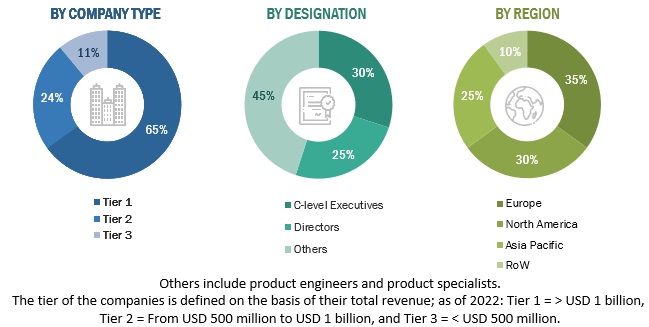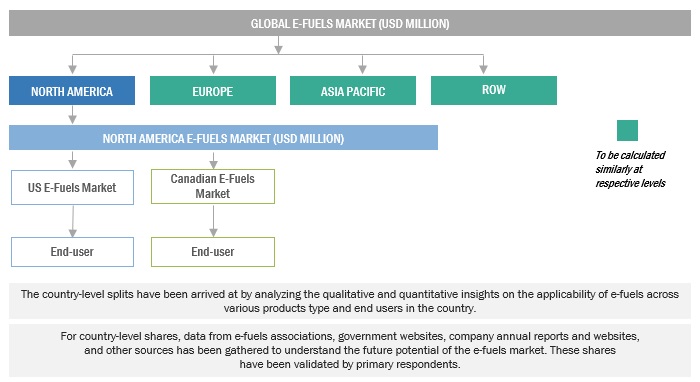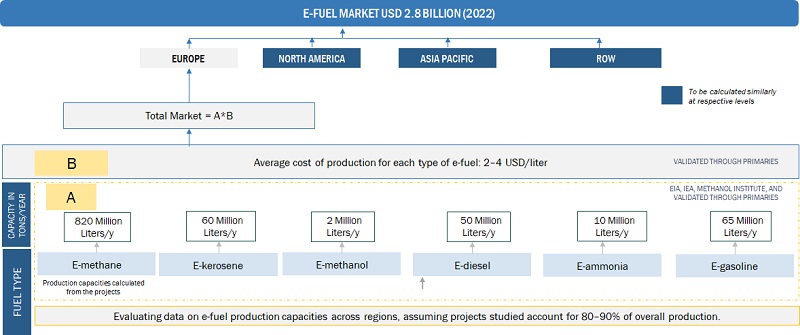The study involved major activities in estimating the current size of the e-fuels market. Exhaustive secondary research was done to collect information on the peer and parent markets. The next step was to validate these findings, assumptions, and sizing with industry experts across the value chain through primary research. Both top-down and bottom-up approaches were employed to estimate the total market size. Thereafter, market breakdown and data triangulation were used to estimate the market size of the segments and subsegments.
Secondary Research
This research study on the e-fuel market involved the use of extensive secondary sources, directories, and databases, such as Hoover’s, Bloomberg, Factiva, IRENA, International Energy Agency, and Statista Industry Journal, to collect and identify information useful for a technical, market-oriented, and commercial study of the market. The other secondary sources included annual reports, press releases & investor presentations of companies, white papers, certified publications, articles by recognized authors, manufacturer associations, trade directories, and databases.
Primary Research
The e-fuels market comprises several raw material supplier technology and EPC providers, e-fuels suppliers, and the end use applications in the supply chain. The demand side of this market is characterized by the rising demand for types of e-fuels such as e-methane, e-methanol, e-ammonia, e-diesel, e-kerosene and e-gasoline. The supply side is characterized by rising demand for contracts from the industrial sector and mergers & acquisitions among big players. Various primary sources from both the supply and demand sides of the market were interviewed to obtain qualitative and quantitative information. Following is the breakdown of primary respondents:

To know about the assumptions considered for the study, download the pdf brochure
Market Size Estimation
Both top-down and bottom-up approaches were used to estimate and validate the total size of the e-fuel market. These methods were also used extensively to estimate the size of various subsegments in the market. The research methodology used to estimate the market size includes the following:
-
The key players in the industry and market have been identified through extensive secondary research, and their market share has been determined through primary and secondary research.
-
The industry’s value chain and market size, in terms of value, have been determined through both primary and secondary research processes.
-
All percentage shares, splits, and breakdowns have been determined using secondary sources and verified through primary sources.
E-fuels Market Size: Top-Down Approach

To know about the assumptions considered for the study, Request for Free Sample Report
E-fuels Market Size: Bottom-Up Approach

Data Triangulation
After arriving at the overall market size from the above estimation process, the total market has been split into several segments and subsegments. Data triangulation and market breakdown processes have been employed to complete the overall market engineering process and arrive at the exact statistics for all the segments and sub-segments, wherever applicable. The data has been triangulated by studying various factors and trends from both the demand- and supply sides. Along with this, the market has been validated using both the top-down and bottom-up approaches.
Market Definition
Renewable or low-carbon liquid or gaseous fuels, known as e-fuels or electrofuels, are produced by combining renewable electricity, often sourced from wind or solar power, with carbon dioxide (CO2). This process creates synthetic hydrocarbon-based fuels, such as e-diesel or e-kerosene, that are intended to replace conventional fossil fuels. E-fuels are particularly useful for aviation and heavy industries, where direct electrification is difficult. However, producing e-fuels requires a significant input of renewable energy and faces challenges in terms of cost and scalability. Despite these challenges, e-fuels can play a crucial role in achieving a sustainable and carbon-neutral energy landscape, helping to combat climate change and reduce greenhouse gas emissions.
The market for e-fuels is the sum of revenues generated by global companies through the sales of e-fuels.
Key Stakeholders
-
E-fuels vendors
-
Consulting companies in the energy & power sector
-
Consulting companies related to the energy & power sector
-
Energy regulators
-
Government and research organizations
-
Power and energy associations
-
Repairs and maintenance service providers
-
State and national regulatory authorities
-
Research and consulting companies in the clean energy generation sector
-
Organizations, forums, alliances, and associations
-
Industrial authorities and associations
-
State and national regulatory authorities
-
Research institutes
Objectives of the Study
-
To define, describe, segment, and forecast the e-fuels market by renewable source, fuel type, state, end use application, and region, in terms of value
-
To describe and forecast the market for six key regions: North America, Europe, Asia Pacific, and RoW along with their country-level market sizes, in terms of value
-
To provide detailed information regarding key drivers, restraints, opportunities, and challenges influencing market growth
-
To strategically analyze the micro markets with respect to individual growth trends, prospects, and contributions to the overall market size
-
To provide supply chain analysis, trends/disruptions impacting customer business, ecosystem/market map, pricing analysis, Porter’s five forces analysis, case study analysis, and regulatory standards pertaining to e-fuels
-
To analyze opportunities for stakeholders in the e-fuels and draw a competitive landscape of the market
-
To strategically analyze the ecosystem, tariffs and regulations, patents, and trading scenarios pertaining to e-fuels
-
To compare key market players based on product specifications and applications
-
To strategically profile key players and comprehensively analyze their market rankings and core competencies
-
To analyze competitive developments, such as contracts and agreements, investments and expansions, mergers and acquisitions, partnerships, joint ventures, and collaborations, in the e-fuels.
Available Customizations:
With the given market data, MarketsandMarkets offers customizations according to the specific requirements of companies. The following customization options are available for the report:
Product Analysis
-
Product Matrix, which provides a detailed comparison of the product portfolio of each company
Company Information
-
Detailed analyses and profiling of additional market players



Growth opportunities and latent adjacency in E-fuels Market